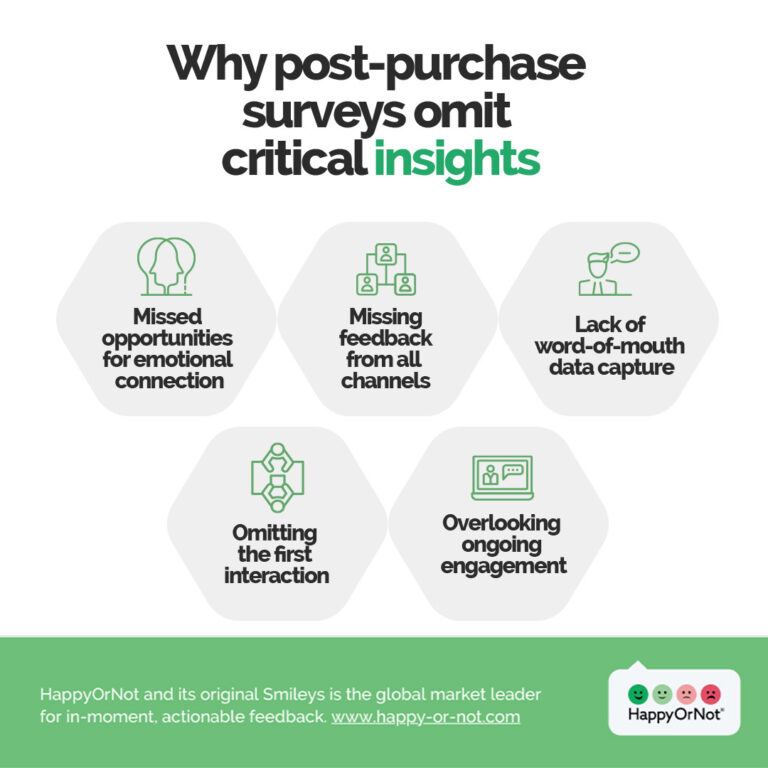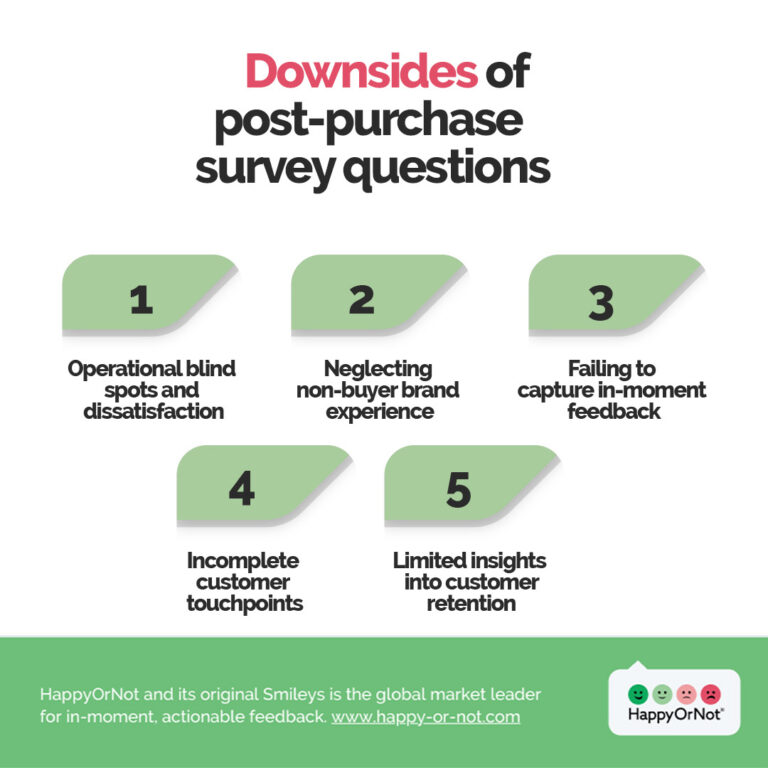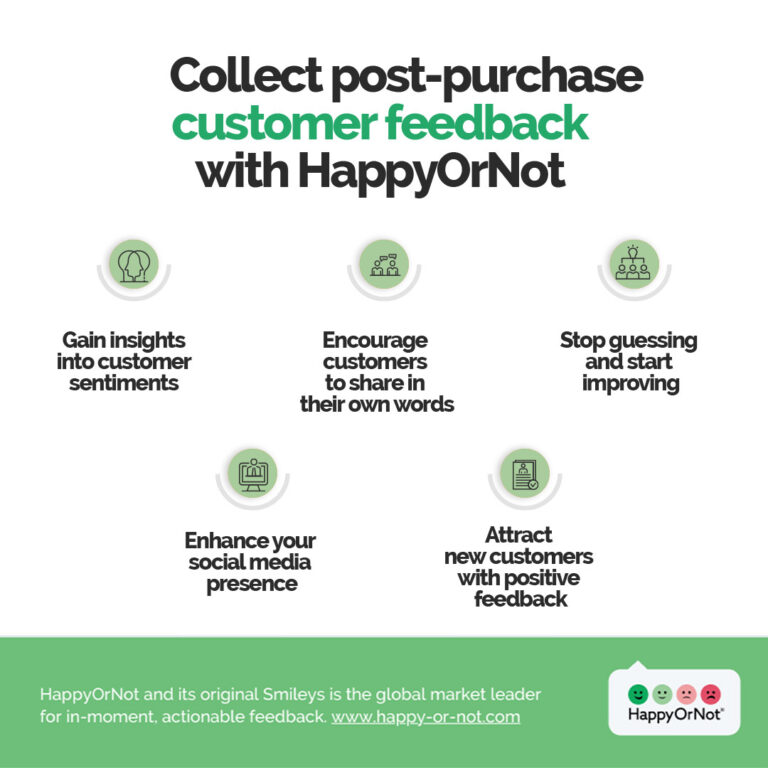What companies get wrong about post-purchase surveys (and how to fix it)
The customer journey doesn’t end with the purchase decision. It typically starts much earlier, and extends far beyond that, including customer interactions, brand experience strategy, and emotional connections. This is why companies should try and measure feedback in real time throughout the journey, from pre-purchase, through the actual purchase, to the after purchase transactions and activities.
Why post-purchase surveys omit critical insights
To create an exceptional customer experience that leads to customer satisfaction and retention, it’s important to understand the customer journey. While post-purchase feedback can be helpful, using only post-purchase surveys can lead to inaccurate results. Post-purchase feedback may not capture all the data necessary to enhance your brand experience strategy and stay ahead in the competitive market.
Here’s what companies usually get wrong.

- Missed opportunities for emotional connection
Post-purchase surveys often fail to capture customers’ feelings during their buying experience. These emotional connections are key factors that encourage customers to become brand advocates, and they can’t be quantified with standard survey questions.
- Missing feedback from all channels
Customers today expect a consistent omnichannel experience and favor businesses that have implemented this experience successfully. Focusing on just post-purchase surveys you might miss important insights about the full customer experience across all channels and fail to provide the same brand image regardless of channel.
- Lack of word-of-mouth data capture
Word of mouth is a powerful tool in the marketing arsenal, and it often originates from exceptional customer experiences. When post-purchase feedback focuses solely on sales or product pages, it may miss customers’ organic thoughts about your brand and the instant impact your service and offering makes on them.
- Omitting the first interaction
Post-purchase surveys usually target customers after they’ve made a purchase. However, a potential customer’s first interaction with your brand can leave a lasting impression, influencing their purchase decision. Not capturing feedback from this initial engagement overlooks a critical aspect of the customer journey that can shape the overall brand experience.
- Overlooking ongoing engagement
Post-purchase surveys are typically sent out once, immediately after a transaction. This one-time approach doesn’t ensure customers provide feedback on their ongoing experiences. To identify areas for improvement and operational efficiency, it’s essential to gather feedback on an ongoing basis, creating a unique brand experience that keeps customers engaged and loyal.
5 downsides of post-purchase survey questions
Surveys come with their own set of drawbacks that could impact your marketing efforts and brand perception. To create a comprehensive understanding of your customer’s journey and improve your marketing efforts, it’s essential to address these shortcomings in your strategy.

- Operational blind spots and dissatisfaction
Post-purchase survey questions primarily focus on the “what” customers bought, whether they are satisfied with their purchase, and their overall experience during the transaction. While this information is essential, companies often need feedback on the “when” and “where” of their full brand experience. Missing this information can lead to operational blind spots and gaps in your customer journey, ultimately affecting customer satisfaction and lifetime value (CLV).
- Neglecting non-buyer brand experience
While post-purchase surveys can help understand buyers’ satisfaction, they often fail to capture the non-buyer brand experience. This is where potential customers who have not purchased engage with your brand. Their feedback is equally important as it can both reveal weak spots in your offering as well as influence their future buying decisions and brand loyalty.
- Failing to capture in-moment feedback
Customers are more likely to give totally honest feedback in the moment of the experience. Failing to capture that immediate feedback may not only lead to lower feedback amounts as people just don’t want to bother again but can also lead to more public venting of their frustration. By giving customers and visitors a channel to give real-time feedback you make sure to capture the immediate reaction to the brand experience you offer.
- Incomplete customer touchpoints
Post-purchase surveys predominantly target the buying experience. However, customer engagement today extends far beyond these touchpoints. Your potential customers interact with your brand through various channels, both online and in-store, before, during, and after the actual buying experience. Neglecting these touchpoints in your survey strategy can result in a skewed perception of your brand’s impact.
- Limited insights into customer retention
By focusing solely on post-purchase transactions, companies may overlook opportunities to understand what makes customers return or not return. More comprehensive surveys encompassing the entire customer path are necessary to gain valuable insights into customer retention.
Collect post-purchase customer feedback with HappyOrNot
HappyOrNot offers a comprehensive solution for collecting customer feedback through the whole customer journey at all touch points, eliminating the disadvantages of traditional surveys. The solutions can help you build a loyal customer base and attract new customers. Here are the 5 key benefits of using this platform.

- Gain insights into customer sentiments
HappyOrNot provides a simple yet effective way to gain insights into perception of your brand’s experience by customers and non-customers alike. By implementing this feedback system on online or at your physical location, you can tap into the unfiltered sentiments of your customers, visitors, buyers, and non-buyers.
- Encourage customers to share in their own words
One of the advantages of HappyOrNot is its ability to encourage customers to share their thoughts and feedback in their own words. This unrestricted approach lets customers express themselves genuinely, providing you with rich, unfiltered insights into their experiences.
- Stop guessing and start improving
Instead of guessing how customers feel about your products or services, HappyOrNot empowers you to gather concrete feedback. This data enables you to make informed decisions and implement changes that resonate with your customer base. By acting on customer feedback, you enhance the overall customer experience and increase the likelihood of turning first-time buyers into repeat customers and loyal customers into brand advocates.
- Enhance your social media presence
HappyOrNot’s feedback data can be leveraged to enhance your social media marketing efforts. When you receive positive feedback from satisfied customers, use it as content for your social media posts. Sharing real-life examples of happy customers and their experiences can attract new customers, boost your brand reputation, and strengthen your social media presence.
- Attract new customers with positive feedback
Showcasing positive feedback from your satisfied customers is a powerful tool for attracting new clients. When potential buyers see that others have had great experiences with your business, they’re more likely to trust your brand and make a purchase. HappyOrNot’s data can serve as social proof, helping you win over new customers and solidify your reputation in the market.
Conclusion
Feedback has become vital for companies to gain insight into customer satisfaction and make informed improvements. However, many companies often fail to get the whole picture by focusing purely on post-purchase feedback.
HappyOrNot has demonstrated how to address these challenges effectively. With our solutions, businesses can gain a more accurate picture of their customers’ experiences and identify areas for improvement.
Frequently asked questions
How does gathering post-purchase feedback contribute to building and maintaining customer loyalty?
Post-purchase feedback is one tool in cultivating and maintaining customer loyalty by demonstrating a commitment to understanding and addressing their concerns or preferences. This process however may fail to catch all aspects of the customer experience, thus failing to foster a deeper connection between the customer and your brand.
How does HappyOrNot make sure the feedback is authentic?
HappyOrNot employs a robust spam filter to safeguard the authenticity of the feedback received, ensuring that the insights gathered accurately reflect your customers’ sentiments.
Can you customize the questions or prompts on the feedback terminals to gather specific post-purchase feedback?
Yes. HappyOrNot allows you to tailor the questions or prompts on the feedback terminals to specifically target the post-purchase feedback if that is what you’re interested in collecting, making it a versatile tool for gaining insights on various aspects of your business.
How does HappyOrNot assist in converting feedback into actionable insights?
HappyOrNot’s system assists in converting feedback into actionable insights by employing sophisticated data analytics and reporting capabilities. These tools help you identify trends, problem areas, and areas for improvement, allowing you to make informed decisions.
Is it possible to integrate HappyOrNot with already implemented business systems and data?
Yes, HappyOrNot offers a comprehensive API that enables seamless integration with your existing business systems and data.